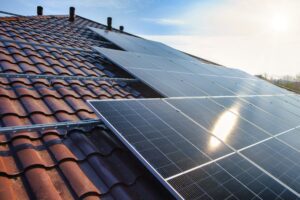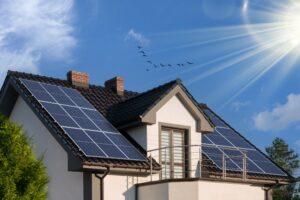Solar panels are now a common sight, and with good reason. They provide homes and businesses with power by generating electricity from an inexhaustible source – the sun.
This free electricity saves money by reducing reliance on the National Grid. It also reduces our carbon footprint, unlike fossil fuels, which drive climate change.
One problem with solar panels, though, is that they take up a lot of space. This is a major obstacle to widescale use of solar power, particularly in cities and towns where available land and the roof space on buildings is at a premium. Another issue is that solar panels don’t offer much visual appeal.
But what if we could get free energy from glass? This may sound like science fiction but research and development of transparent solar panels is bringing it closer to reality.
How Do Transparent Solar Panels Work?
Solar cells absorb photons – small packets of energy from the sun – and convert them into electricity (electrons).
Transparent solar cells do this with a translucent solar concentrator. This absorbs light invisible to the naked eye but visible light passes through.
See-through solar panels have been developed with state-of-the-art renewable energy technology with the aim of incorporating solar power into common structures and surfaces.
They use a new type of solar cell that allows daylight to pass through while still being able to generate power, so they’re suitable for use on windows and other transparent surfaces.
Transparent solar cells absorb all the energy from the sun except the part that allows us to see.
PV solar glass can be used in various applications, from generating electricity for entire buildings to using greenhouses and glass facades to produce energy, and powering devices such as laptops and smartphones.
Researchers are working on ways to advance solar glass technology and make it commercially practical on a large scale, expanding the options of solar power dramatically and changing how we think about generating energy.
Potential uses of transparent solar panels are virtually endless, in buildings, electronics, vehicles, boats, buildings, and other applications.
- Create a Tailored Quote Based On Your Circumstances
- Takes Less Than 2 Minutes
- Fixed-Online Quotes

The Science Behind Transparent Solar Panels
Light comprises electromagnetic radiation across a range of wavelengths containing energy that can potentially be captured by a solar cell.
The human eye detects only some of this light. Transparent solar cells allow this visible light to pass through to our eyes. The rest is absorbed by the solar cell for conversion into energy.
While replicating the photovoltaic (PV) system of standard solar panels, the solar cells of clear solar panels have a layer that allows entry of visible light while collecting ultraviolet (UV) and near-infrared energy.
A phenomenon in physics and chemistry, the photovoltaic effect turns light into energy, using a semiconductor like silicon – the same material in microchips.
Types of Transparent Solar Panels
There are two types of transparent solar panels that can generate power from everyday surfaces: fully transparent and partially transparent.
Fully Transparent Solar Panels
Fully transparent solar panels look like regular glass. They use solar cells with semiconducting silicon and special glass and plastic that act as semiconductors rather than insulators.
They were developed in America by Michigan State University in 2014. Researchers came up with a transparent luminescent solar concentrator (TLSC) using organic salts that absorbed invisible wavelengths of light.
In 2020, they produced solar glass regarded as being full transparent – with 86% translucence.
Partially Transparent Solar Panels
Partially transparent solar panels were developed by German startup Heliatek GmbH with solar glass that absorbs 60% of light with 7.2% energy conversion efficiency.
These types of solar panels could be ideal as tinted glass, with solar windows on the south face of buildings, for example.
Partially transparent solar panels use ultra-thin layers of semiconducting materials such as amorphous silicon or cadmium telluride sandwiched between two sheets of solar glass.
Advantages of Transparent Solar Panels
Like conventional solar panels, transparent solar panels reduce reliance on polluting fossil fuels and emit no greenhouse gases. But the see-through qualities of these solar panels set them apart from regular solar panels, which are opaque and coloured blue or black.
While traditional solar panels are ideal for roofs and solar farms, they’re not designed for widescale use in high-density areas and applications requiring lightweight solar cells.
The emerging solution is solar glass, which could be a major source of renewable energy for the future, with many advantages and ideal for optimising renewable energy in urban areas where space for standard solar panels is limited.
The technology behind clear solar panels is still in its infancy but has the capability to revolutionise how we produce and use electricity, with commercial applications on a large scale – free energy from the likes of windows, glass roofs, car windshields and sunroofs, and even smartphone touch screens.
Because clear solar panels are lighter than traditional solar panels, they’re more portable and easier to install.
Solar Glass in Buildings
Clear solar panels fall into the category of building-integrated photovoltaics (BIPVs) and can be incorporated into building structures such as roofs, windows and doors.
Solar glass – thinner and lighter than traditional solar panels – can power a building by harnessing solar energy without blocking natural light. This makes transparent solar panels a good fit for structures with a modern design, blending seamlessly into the architecture.
PV solar glass researchers at Massachusetts Institute of Technology estimate that solar windows in a skyscraper could provide more than 25% of the building’s energy needs.
Solar Glass in Electronic Devices
Solar glass can turn electronic consumer products such as mobile devices into their own power generators.
It could partially recharge the batteries of smartphones and laptops, for instance, to help run screen displays on ambient light without changing how the device works or looks.
Disadvantages of Transparent Solar Panels
Conventional solar panels have monocrystalline or polycrystalline solar cells, which are more efficient than the solar cells in transparent solar panels.
The limited efficiency of solar glass means it’s not a convenient energy solution for most homes.
Most residential solar panels convert around 20% of sunlight into electricity. The efficiency level of fully clear solar panels is currently about 1% but this figure could potentially rise to 5%.
Despite being less efficient, potential applications of solar glass mean it could still be widely used and a practical solution in other ways.
A further problem with see-through solar panels is limited supply. Solar glass technology is relatively new so transparent solar panels are not yet common in commercial applications. This will change, though, as the technology improves.
Engineers in America have already developed see-through solar panels with a zinc-oxide layer they expect to last 30 years – comparable with the lifespan of conventional solar panels.
Other drawbacks of transparent solar panels include:
- Less durability. Because transparent solar cells are based on organic materials, they may degrade quickly.
- Fragility. The glass in transparent solar panels is more fragile than that of regular solar panels. So more care in handling them is needed to avoid breakages.
An Energy Revolution in the Making
As a sustainable and aesthetically pleasing solution to energy needs, transparent solar panels have opened up exciting possibilities for solar power. They have potential to transform how we generate and use electricity, with numerous advantages over standard solar panels.
See-through solar panels are currently expensive but as the technology behind them continues to develop, the cost is likely to come down, making them more accessible to homeowners and businesses, and with almost limitless uses.
There may still be a long road ahead before transparent solar panels become an everyday reality, but thanks to groundbreaking solar technology the dream of a solar-powered future may not be as far away as we think.
Meanwhile, traditional solar panels continue to provide homes and businesses with clean renewable energy that saves money by reducing dependence on the National Grid by generating as much solar energy as possible in a limited space.
- Create a Tailored Quote Based On Your Circumstances
- Takes Less Than 2 Minutes
- Fixed-Online Quotes




